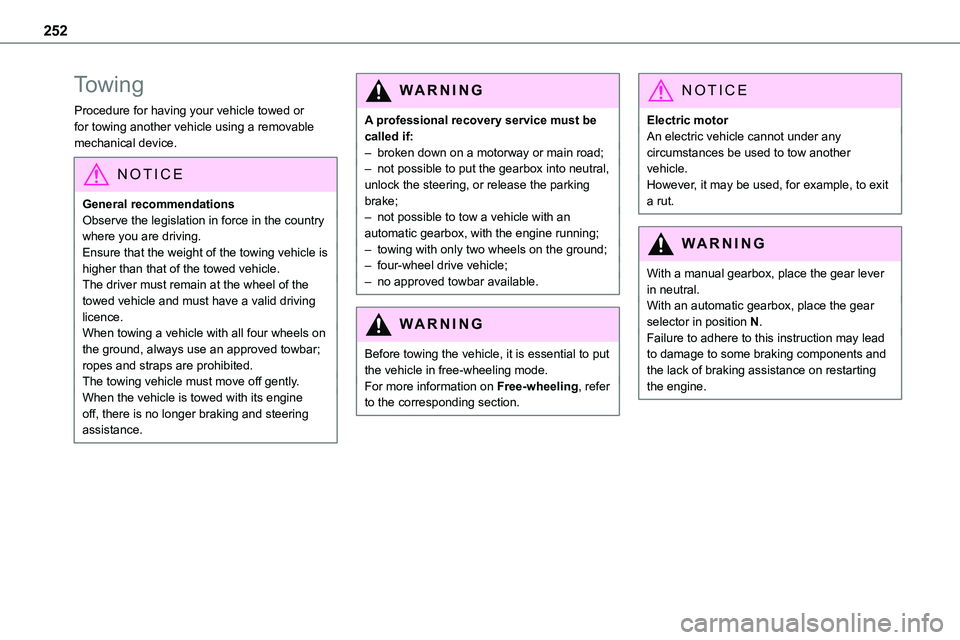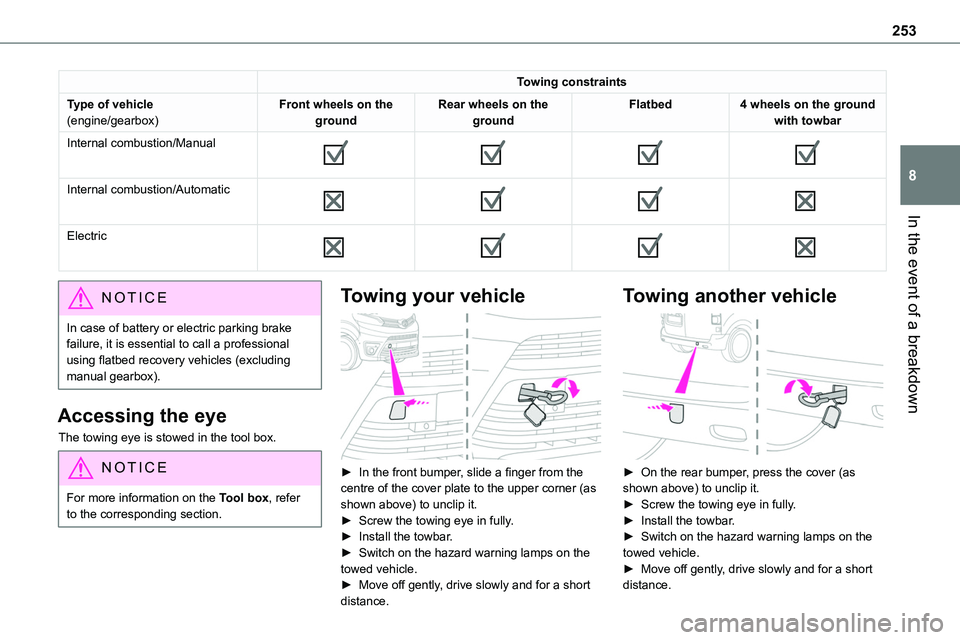Page 252 of 360

252
Towing
Procedure for having your vehicle towed or for towing another vehicle using a removable mechanical device.
NOTIC E
General recommendationsObserve the legislation in force in the country
where you are driving.Ensure that the weight of the towing vehicle is higher than that of the towed vehicle.The driver must remain at the wheel of the towed vehicle and must have a valid driving licence.When towing a vehicle with all four wheels on the ground, always use an approved towbar; ropes and straps are prohibited.The towing vehicle must move off gently.When the vehicle is towed with its engine off, there is no longer braking and steering assistance.
WARNI NG
A professional recovery service must be called if:– broken down on a motorway or main road;– not possible to put the gearbox into neutral, unlock the steering, or release the parking brake;– not possible to tow a vehicle with an
automatic gearbox, with the engine running;– towing with only two wheels on the ground;– four-wheel drive vehicle;– no approved towbar available.
WARNI NG
Before towing the vehicle, it is essential to put the vehicle in free-wheeling mode.For more information on Free-wheeling, refer to the corresponding section.
NOTIC E
Electric motorAn electric vehicle cannot under any circumstances be used to tow another vehicle.However, it may be used, for example, to exit a rut.
WARNI NG
With a manual gearbox, place the gear lever in neutral.With an automatic gearbox, place the gear selector in position N.Failure to adhere to this instruction may lead to damage to some braking components and the lack of braking assistance on restarting the engine.
Page 253 of 360

253
In the event of a breakdown
8
Towing constraints
Type of vehicle(engine/gearbox)Front wheels on the groundRear wheels on the groundFlatbed4 wheels on the ground with towbar
Internal combustion/Manual
Internal combustion/Automatic
Electric
NOTIC E
In case of battery or electric parking brake failure, it is essential to call a professional using flatbed recovery vehicles (excluding manual gearbox).
Accessing the eye
The towing eye is stowed in the tool box.
NOTIC E
For more information on the Tool box, refer to the corresponding section.
Towing your vehicle
► In the front bumper, slide a finger from the centre of the cover plate to the upper corner (as shown above) to unclip it.► Screw the towing eye in fully.► Install the towbar.► Switch on the hazard warning lamps on the towed vehicle.
► Move off gently, drive slowly and for a short distance.
Towing another vehicle
► On the rear bumper, press the cover (as shown above) to unclip it.► Screw the towing eye in fully.► Install the towbar.► Switch on the hazard warning lamps on the towed vehicle.► Move off gently, drive slowly and for a short
distance.
Page 255 of 360
255
Technical data
9
Engines and towed loads - Diesel EURO 5 (only Ukraine)
PROACE VAN
Engines2.0D-4D 150HP
GearboxesManual 6-speedAutomatic 8-speed
Code4WZ-FTV (DW10FD)
Cubic capacity (cc)1,997
Max. power: EC standard (kW)11 0
FuelDiesel
LengthCompact/Medium/Long(L1/L2/L3)Medium*/Long*(L2/L3)*Compact/Medium/Long(L1/L2/L3)Medium*/Long*(L2/L3)*
Braked trailer (within the GTW limit) (kg)on a 10% or 12% gradient
1,000800
Unbraked trailer (kg)750750
Maximum authorised nose weight (kg)921008088
Page 256 of 360
256
Engines and towed loads - Diesel EURO 6.3
PROACE VAN
Engines1.5D-4D 100HP1.5D-4D 120HP
GearboxesManual 6-speedManual 6-speed
Code5WZ-TV (DV5RUCd)5WZ-HV (DV5RUC)
Cubic capacity (cc)1,4991,499
Max. power: EC standard (kW)7588
FuelDieselDiesel
LengthCompact/Medium/Long(L1/L2/L3)Medium*/Long*(L2/L3)*Compact/Medium/Long(L1/L2/L3)Medium*/Long*(L2/L3)*
Braked trailer (within the GTW limit) (kg)on a 10% or 12% gradient
1,0001,000
Unbraked trailer (kg)750750
Maximum authorised nose weight (kg)72807280
* Increased payload.
Page 257 of 360
257
Technical data
9
Engines2.0D-4D 144HP2.0D-4D 180HP
GearboxesManual 6-speedAutomatic 8-speedAutomatic 8-speed
Code4WZ-FTV (DW10FDDU)4WZ-FHV (DW10FDCU)
Cubic capacity (cc)1,9971,997
Max. power: EC standard (kW)106130
FuelDieselDiesel
LengthCompact/Medium/Long(L1/L2/L3)
Medium*/Long*(L2/L3)*Compact/Medium/Long(L1/L2/L3)
Medium*/Long*(L2/L3)*Compact/Medium/Long(L1/L2/L3)
Medium*/Long*(L2/L3)*
Braked trailer (within the GTW limit) (kg)on a 10% or 12% gradient
1,100800800
Unbraked trailer (kg)750750
Maximum authorised nose weight (kg)728072808088
Page 258 of 360
258
Engines and towed loads - Diesel EURO 6.3
PROACE VERSO
Engines1.5D-4D 120HP2.0D-4D 145HP2.0D-4D 180HP
GearboxesManual 6-speedManual 6-speedAutomatic 8-speedAutomatic 8-speed
Code5WZ-HV (DVRUC)4WZ-FTV (DW10FDDU)4WZ-FHV (DW10FDCU)
Cubic capacity (cc)1,4991,9971,997
Max. power: EC standard (kW)88106130
FuelDieselDieselDiesel
LengthCompact/Medium/Long(L1/L2/L3)
Medium*/Long*(L2/L3)*
Compact/Medium/Long(L1/L2/L3)
Medium*/Long*(L2/L3)*
Compact/Medium/Long(L1/L2/L3)
Medium*/Long*(L2/L3)*
Compact/Medium/Long(L1/L2/L3)
Medium*/Long*(L2/L3)*
Braked trailer (within the GTW limit) (kg)on a 10% or 12% gradient
6-7-8-9 seats1,4001,9001,8001,9001,8001,9001,800
Unbraked trailer (kg)750750750750
Maximum authorised nose weight (kg)
84848484
* Increased payload.
Page 260 of 360
260
Towed loads
Model codes:ZZKXZ
Braked trailer (within the GTW limit) (kg)on a 10% or 12% gradient1,000
Unbraked trailer (kg)750
Maximum authorised nose weight (kg)60
Model codes:V1ESZ/V1EZZ/VZESZ/VZEZZ
Code:MEL ZAE BATT S/MEL ZAE BATT XL
LengthCompact, Medium, Long(L1/L2/L3)
Braked trailer (within the GTW limit) (kg)on a 10% or 12% gradient5-6-7-8-9 seats1,000
Unbraked trailer (kg)750
Maximum authorised nose weight (kg)60
Page 320 of 360

320
Recording event data
Electronic control units are installed in your vehicle. These control units process data received from the vehicle's sensors, for example, or data they generate themselves or exchange with each other. Some of these control units are required for the correct operation of your vehicle, some others assist you while driving (driving or
manoeuvring aids), while others provide comfort or infotainment functions.The following contains general information about how data is processed within the vehicle.You will find additional information about the specific data which is downloaded, stored and transmitted to third parties and what it is used for in your vehicle under the keyword "Data protection". This information is directly associated with the references for the functions in question contained in the corresponding vehicle handbook, or in the general terms and conditions of sale.This information is also available online.
Vehicle operating data
The control units process the data used for the operation of the vehicle. This data includes, for example: – Information about the state of the vehicle (e.g. speed, travel time, lateral acceleration, wheel rotation rate, fastened seat belts display). – Environmental conditions (e.g. temperature, rain sensor, distance sensor).
As a general rule, this data is temporary, is not stored for longer than one operating cycle and is only used within the vehicle itself. The control units often record this data (including the vehicle's key). This function allows either the temporary or permanent storage of information about the state of the vehicle, stresses on components, servicing requirements, as well as events and technical errors. Depending on the vehicle's equipment level, the data stored is as follows: – Operating state of system components (e.g. filling level, tyre pressures, battery charge status). – Faults and malfunctions in important system components (e.g. lamps, brakes). – System reactions in specific driving situations (e.g. deployment of an airbag, triggering of stability control and braking systems). – Information about events which have damaged the vehicle.
– For electric and rechargeable hybrid vehicles, the traction battery charge level and the estimated driving range. In particular circumstances (e.g. if the vehicle has detected a malfunction), it may be necessary to record data which would otherwise simply not be stored. When taking your vehicle in for servicing (e.g. repairs, maintenance), the stored operating
data may be read along with the vehicle's identification number and used if necessary. The personnel working for the servicing network (e.g. garages, manufacturers) or third parties (e.g. roadside assistance agents) may read the vehicle's data. This also applies to work carried out under warranty and quality assurance measures. This data is generally read via the OBD (On-Board Diagnostics) port fitted by law to the vehicle. It is used to report on the technical state of the vehicle or its components and facilitates the diagnosis of malfunctions, in compliance with warranty obligations and for quality improvement. This data, in particular the information relating to stress on components, technical events, operator errors and other malfunctions, is sent to the Manufacturer, if necessary, along with the vehicle's identification number. The Manufacturer's liability may also be engaged. The Manufacturer may also use the operating data taken from the vehicle for product recalls. This data may also be used to check the